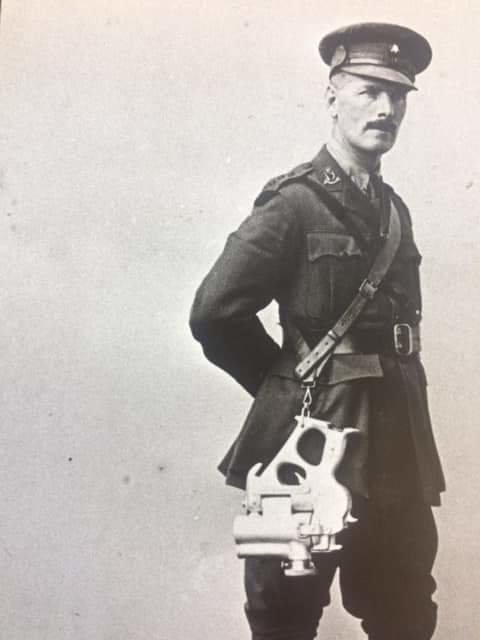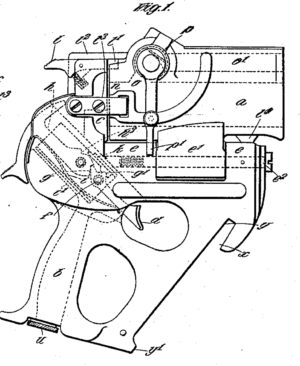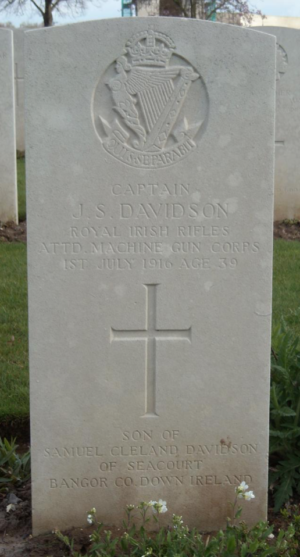Some time last year I encountered this strange photo, which I assumed was a peculiar weapon of some sort developed in WW1.

At first I thought it was some form of captive bolt “humane-killer” for horses, with the hook in front of the trigger designed to hook onto the bridle of a horse, perhaps for use under bombardment – the hand-guard protecting the veterinarians hand from snapping teeth. But I couldn’t explain other aspects of the complex system on the “top” of the weapon. I put out a plea for help last summer on social media but got no useful answers at the time. A couple of days ago I thought I’d try again and this time with success. So here is the story of this exotic weapon, named by the inventor as a “hand howitzer. I’d like to thank a number of folk who helped me find this – much appreciated.
The inventor was a Northern Irish engineer, by the name of Samuel Cleland Davidson. He did not have any great education, leaving school at the age of 15, but he clearly had an aptitude for engineering and he was an avid experimenter. After some time in the tea trade, he invented a range of machinery to help with the processing of tea leaves. One of his inventions was particularly successful, a system using a centrifugal fan to blow hot air over drying tea leaves, and his engineering factory in Belfast was called Sirocco, presumably a reference to a “hot wind”. His company “Davidson and Co” went on to make a wide variety of fans and other related mechanical engineering equipment. His company made fans for the Titanic, built at the adjacent shipyard in Belfast, as well as for other ships around the world. Indeed during WWI it would appear that the entire German naval fleet were equipped with Sirocco fans.
Davidson was already 68 years old at the start of WW1, but his son James was an officer, who was killed on the Somme.
Now as readers of the blog will know, there was a lot of innovation encouraged in WW1 to address the particular challenges of trench warfare. Quite a number of grenade and trench mortar systems were developed with varying degrees of success and sophistication and I’ve covered some of these such as the Garland trench mortar in earlier blog posts. The British Army and the Australian army set up “Munitions Inventions Departments” and these developed and tested such innovations. At some stage, perhaps driven by his son’s experiences. Davidson designed a grenade launcher. Unlike some of the cruder systems that abounded, the “hand howitzer” was somewhat more sophisticated, giving the ability to adjust the rage of the grenade mechanically. He achieved this by having a system that vented the breech to a lesser of greater degree. If the vent was fully closed the range of the grande would consequently be maximised and the range was shortened incrementally by adjusting the vent. By implication the system, had some sort of mechanism to check the level or the angle of launch. The full US patent for the system is here and open can see some sort of inclinometer on the side not shown in the photo above. The hook allows the system to be held firm while checking the inclinometer. There were two versions, one hand held, and one fired from a tripod.
Here’s an extract from one of the diagrams in the patent. Note that there diligent engineer that Davidson was, has included a built in oil bottle into the bottom of the system (“u”).

Davidson’s son, James, was serving with 36 (Ulster) Division and was killed on 1 July 1916, the first day of the Somme. He was a Captain in the Machine Gun Corps. Some personal details of James Davidson are here. Other details are here. Although it has perhaps little bearing on his father’s invention, which brought me to this subject, one cannot but be moved by the story of his death. After eight o’clock on the morning of 1 July 1916, in response to a request for a Vickers Gun, the official battalion War Diary for the 13th Royal Irish Rifles reported that “Captain Davidson whose guns were in reserve was then sent out.” At 10.20 am, the War Diary notes, Davidson reported:
“Am in B line & have got up two Vickers Guns, am consolidating both. Cannot say how many infantry are in line … We cannot possible advance & reinforcements, ammn [sic] & bombs most urgently needed.”
At 12.40 pm he sent a further message:
“I am holding the end of a communication trench in A Line with a few bombers & a Lewis gun. We cannot hold much longer. We are being pressed on all sides and ammunition almost finished.”
His family received a number of letters from his fellow soldiers. One was from Lieutenant WW Ashcroft written on July 3rd, 1916. He too was a member of the Machine Gun Company of the 108th Brigade, and noted of James Davidson that “It was through him that I came to the 13th [Royal Irish Rifles]…” He went on to describe to Davidson’s father the events around his son’s death:
“When things went badly, and he no doubt felt his obvious duty was to take up reinforcements, off he went, and for a long time he held up more or less single handed a dangerous position; although shot through the knee, he refused to be carried back; alternately he fired his Gun, and threw bombs until he had to retire to bind up his wound; he returned, and did what he could, and finally he started back to try and find reinforcements. He was shortly after shot through the head.”
Another, Gunner Thomas Pinkerton wrote in August 1916 to Samuel Davidson that he had been with his son when, having held out in the trenches despite being shot through the knee, Davidson had decided to try to get back to the British lines:
“We got to the German front line trench and went down the trench about 200 yards to get as much dead ground as possible. I topped the parapet, and helped the Captain up, and had just got through the wire when I noticed about a dozen men on my left, a few yards up, retiring. Just then the Germans opened a deadly Machine Gun and Rifle fire on us – we just got 20 yards from the wire when the Captain got shot through the head – he just fell, and never spoke nor moved. He died instantly – there was no hope.”
James Davidson’s body was lost in the confusion of the Somme. Twelve years later his body was found on the south side of the Ancre Valley, and identified from an engraved compass found in his pocket. He is now buried in the Serre Road Cemetery, No2, but his name also appears on the Theipval Memorial to the missing.

Samuel Davidson’s invention was registered and patented in 1917, the following year. It is said he was negotiating a significant order for the hand howitzer with the US army but the end of the war came first and the design was shelved. He was knighted in 1921.
I will have more on WW1 Munitions Inventions Departments activity in future posts.

Roger, well done for persevering on this one, some excellent research and an impressive result. Knowledge not shared is lost so fantastic news that this man and his engineering skill has come to light over a hundred years later. JB
Well done, the writer of this blog. You did really well finding out so much as a result of seeing a photograph – one I’ve never seen before.
Sam Davidson was my great grandfather. My grandmother, Kathleen, was his youngest child. She had a photo of him next her bed posing with his hand on the trigger of his howitzer, this one mounted on a square post. I have a letter he wrote from London to his wife Clara on his 70th birthday detailing his efforts to interest the War Ministry in the howitzer. He called at the Foreign Office with a distant cousin he refers to as ‘Ned’ who seems to have been Sir Walter Edward Davidson, in London between appointments as governor or Newfoundland and governor of New South Wales. He also renewed acquaintance with PM Asquith’s Personal Private Secretary Sir Maurice Bonham-Carter (he writes Bonner-Carter) through whom he hopes to arrange a meeting with Asquith himself. Only two weeks later Asquith resigned and Lloyd George became PM. The government showed no further interest, which would explain why he sought interest in the USA.
I also have the mangled, engraved compass by which the remains of Sam’s son James were identified, a letter sent to my grandmother in 1930 from the War Graves Commission confirming the identity of the remains as Jim’s, and also Jim’s dress uniform which has been on display at the local museum during Somme and Armistice centenary celebrations. The compass must have been returned to the family.
A blue plaque was unveiled in Belfast in March 2020 commemorating Sam Davidson. Four great grandchildren and two great great grandchildren were at the ceremony.
A former teacher, Eric Woods, who has no connection either with the family or with the Sirocco Works, has become very interested in SCD and is hoping to complete a biography of him in time for the centenary of his death in 1921. I would be very interested in making contact with the writer of the blog and putting him in touch with Eric Woods.
Author
Very happy to be put in touch with Mr Woods. My email address is rogercdaviesXme.com where X is replaced by @ [Given this way to prevent bots scraping my email address and sending me spam] Thank you for adding the fascinating family detail.
I am his great great grandson. We have some amazing pics of him testing his Hand Howitzer, including over the wall of his family home, Seacourt, into the sea!
Author
Would love to see those photos!
My wife’s great great grandfather, Henry Shaw Wyllie 1852-1919, was a tea planter in Assam, India 1870-1881. He was evidently a friend of Samuel Cleland Davidson per this excerpt from Sam’s diary:
‘Had expected Wyllie over to breakfast today as he had had most severe and cutting letters from Jack and Stewart of Playfair,Duncan & Co about his approaching marriage. They ridicule the idea of attempting it in fear of R’s125/- per month, and indeed they are quite right and if she has not got something and his pay doesn’t soon rise he will have nasty times of it it no doubt making ends meet. He didn’t come over today,however, Wyllie came over today for breakfast and to jaw over his letter. I told him plainly that I thought Jack & Stewart were right in the main though their language was insulting but he says his pay is to rise next year to R’s200/- and that Miss Cobb will have a yearly allowance from her garden.’
d
Wyllie was an assistant manager of the Dalu/Doloo tea garden north of Sylchar, India from about 1870 to 1874. He later managed an estate 25 miles from Dibrugarh 1874-1881. I’d be grateful for any more information about his tea planting days in any of SCDs writings. Or if you could direct me to anyone else for further research.
Thanks so much,
Bob Foran
This would make a wonderful article for Armax: The Journal of Contemporary Arms. Please email me if you’re interested in that.
Author
Thanks Nic, I’m flattered. Armax is highly regarded and of course has high academic standards. My little old blog is easy to do, and I’d have to rewrite it with sources etc etc (and correct my spelling mistakes!). I’ll consider your kind suggestion.